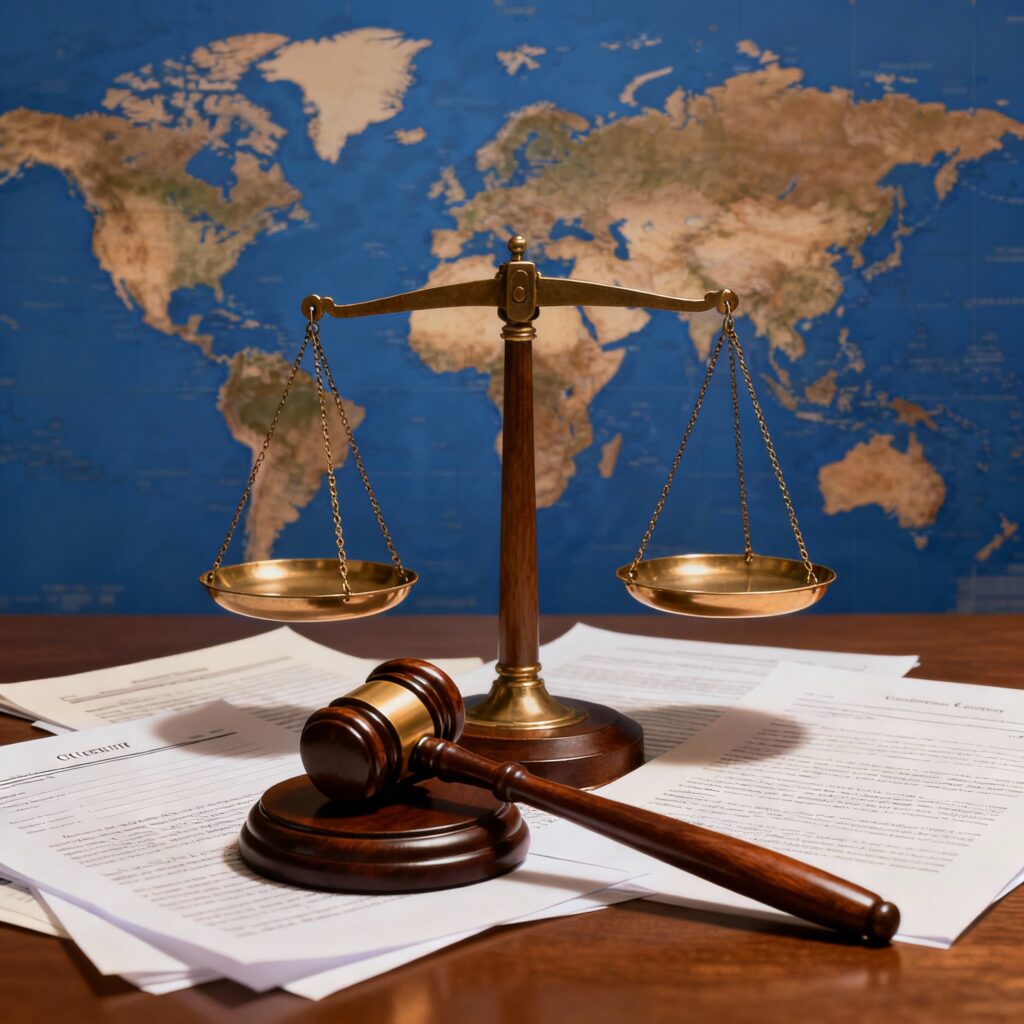Published on 22nd July 2025
Authored By: Shruti Kumari
National Law University Meghalaya
Abstract
The consequences of climate change, such as flooding, desertification, rising sea levels, and extreme weather, are displacing millions of people worldwide. However, international law still does not formally recognize or protect “climate refugees.” The 1951 Refugee Convention, the primary piece of legislation pertaining to refugee protection, does not cover displacement caused by environmental factors. This study examines the legal vacuum surrounding climate-induced displacement, assesses state responses and soft law tools, and makes recommendations for reforms to establish a rights-based, globally coordinated legal framework. Using significant case law, international agreements, and doctrinal analysis, the paper argues for legal innovation to address the escalating issue of migration related to climate change.
Keywords: Refugee Convention, Human Rights Law, International Migration, Climate Refugees, Environmental Displacement, legal reform.
Introduction
Climate change has evolved from environmental problems to a crisis affecting human rights and displacement. Communities in low-lying island nations, densely populated deltas, and arid regions are disproportionately affected by the world’s unprecedented rise in climate-induced displacement. According to the Internal Displacement Monitoring Center, in 2022 alone, weather-related disasters caused the displacement of over 32.6 million people.[1]
However, these displaced people are not officially protected or recognized by international law. One important piece of refugee law, the 1951 Convention Relating to the Status of Refugees (“1951 Convention”) [2], does not address displacement brought on by environmental factors. Millions are in limbo because of this legal blind spot. Three main questions are intended to be addressed in this paper: Who are the climate refugees? What protection do they enjoy under current international legal frameworks? And what reforms are necessary to ensure their rights?
Conceptual Framework: Who Are Climate Refugees?
In the policy and media disclosure, the term “climate refugee is being widely used, however yet it has not made its place when it comes to international law. As defined under The International organization for migration (IOM), “environmental migrants” refers to as individual or groups who are mostly compelled to leave their residential places due to sudden or gradual environmental changes that adversely affects their lives.[3]
The United Nations High Commissioner for Refugees (UNHCR) situates these situations within broader protection frameworks rather than calling them “climate refugees.”[4] Despite acknowledging “climate-related displacement,” the Global Compact for Safe, Orderly and Regular Migration contains optional and non-binding provisions.[5]
The 1951 Convention requires that a person have a “well-founded fear of persecution” because of their race, religion, nationality, political beliefs, or membership in a particular social group. [6] People who have been displaced solely due to environmental or climate-related factors are not included in this definition. The fact that many of them migrate across borders or are internally displaced in order to survive further complicates their legal classification.
International Legal Framework and Its Limitations
The existing 1951 convention and its protocol have been proven inadequate when we talk about addressing the modern patterns of displacement. The persecution-based refugee definition fails to cover the realities of people displaced by severe drought, rise, or hurricanes.[7]
Climate change affects rights like life, housing, and health, which are protected by human rights treaties like the International Covenant on Civil and Political Rights (ICCPR) [8] and the International Covenant on Economic, Social, and Cultural Rights (ICESCR) [9]. However, in the context of climate displacement, these tools are not directly enforceable.
The UN Guiding Principles on Internal Displacement [10] and the Sendai Framework for Disaster Risk Reduction [11] are two examples of soft law instruments that offer guidelines but have no legal force.
Ioane Teitiota v. New Zealand was a historic case that was presented to the UN Human Rights Committee. Teitiota, a Kiribatian, invoked the non-refoulement principle of the ICCPR to argue that his life was in danger due to rising sea levels. Though the committee refused to uphold his asylum claim, it acknowledged that severe environmental degradation would, in extreme cases, trigger non-refoulement obligations.[12]
Case Studies: Ground Realities of Climate Displacement
Pacific Islands: Rising sea levels pose existential risks to Kiribati and Tuvalu. In preparation for a potential future move, Kiribati has already acquired land in Fiji. However, under refugee law, their citizens are not recognized.
South Asia: Bangladesh experiences mass evictions as a result of yearly flooding and river erosion. Many travel to India, where they are denied legal protection and refugee status, exacerbating sociopolitical tensions.[14]
Sahel Region: Climate change has exacerbated resource scarcity and desertification in nations like Mali and Chad, leading to conflict and displacement.[15] The law ignores these displacements even though they are caused by climate change.
Central America: Some Central American countries, for example, Honduras and Guatemala, are frequently affected by climate disasters. However, unless persecution on traditional grounds can be demonstrated, migrants who apply for asylum in the United States are denied entry. [16]
These examples reveal the urgent need for legal reforms to accommodate climate-induced displacement.
Disproportionate Impact on the Underprivileged: A Climate Justice Lens
Climate change affects everyone, but not everyone is equally affected. The poor are disproportionately affected by the most severe injustices caused by the displacement brought on by climate change because they contribute the least to the phenomenon but are most impacted by its effects. Marginalized communities often reside in climate-vulnerable areas, such as riverbanks, floodplains, slums, and subsistence farmlands without official title or state protection. When disasters strike, these communities are the first to lose their homes, their means of subsistence, and access to essential services.
The social capital, wealth, and education that are frequently required for safe relocation and reconstruction are less likely to be available to those living in poverty. However, because they have access to insurance, private relocation options, or even transnational mobility, privileged people are shielded from total displacement.
This inequality creates a vicious cycle of vulnerability by exposing the poor to environmental risks and legal invisibility.
Women, children, indigenous peoples, and informal workers are particularly vulnerable because they are often excluded from decision-making processes related to relocation or adaptation. Many internally displaced people lack access to legal documentation, property restitution, and public relief programs. For instance, in South Asia, government rehabilitation initiatives frequently ignore tribal and Dalit communities that have been uprooted due to flooding and erosion.
The necessity of a legal strategy based on climate justice is highlighted by this systemic injustice. When creating protection measures, it is important to consider not only displacement itself but also the intersectionality of vulnerability—the ways that poverty, caste, gender, migration status, and environmental degradation all interact to increase risk. Without this viewpoint, climate law may serve to strengthen existing hierarchies rather than to abolish them.
Recognizing the unequal burdens borne by the underprivileged must inform both legal reform and institutional design, ensuring that protection is not just universally available but equitably accessible.
Bridging the Legal Gap: The Case for Recognition
According to legal experts like Jane McAdam, current international law does not sufficiently address slow-onset phenomena like sea level rise and desertification. [17]
There are three main barriers to advancement:
• Cause Attribution: Since climate displacement often has several causes, it can be challenging to categorize.
• State Sovereignty: Countries are reluctant to take on more international obligations.
• Lack of Political Will: Geopolitical interests impede the creation of internationally enforceable standards.
A new protocol for climate-displaced persons or an amendment to the 1951 Convention are two of the proposed legal paths.
• Creating a unique Climate Displacement Agreement.
• Assisting regional structures with equitable burden-sharing plans.
Environmental law’s Common but Differentiated Responsibilities (CBDR) principle upholds the idea that developed countries, which bear the burden of historical emissions, ought to provide assistance to those affected by climate change. [18]
National and Regional Innovations
A few nations have made modest moves in spite of the lack of an international agreement:
New Zealand has expressed interest in protecting those displaced by climate change and offered a Pacific Access Category visa. [19]
For environmental displacement, Sweden and Finland offer short-term humanitarian protection.
The first legally binding regional agreement that acknowledges environmental causes of displacement is the Kampala Convention, which has been ratified by the African Union. [20]
Despite its extreme vulnerability, South Asia has neither a cooperative framework nor a legal tool for climate migration. Climate considerations are included in the Global Compact on Migration (2018), although it is up to national discretion and is not legally binding. [21]
Reform Recommendations and Legal Innovations
The following actions must be taken to guarantee that climate refugees are adequately protected:
- New International Treaty: Create a binding contract that identifies and safeguards people who have been displaced by climate change.
- Protocol to the Refugee Convention: Add those displaced by climate change to the definition of refugees.
- Climate Visas: Countries ought to grant humanitarian visas to those who have been displaced by natural disasters.
- Regional Cooperation: Organizations such as the Pacific Islands Forum, ASEAN, and SAARC must reach agreements that are specific to the needs of the region.
- Institutional Expansion: Environmental displacement should be included in the UNHCR’s mandate. The Human Rights Council has the authority to designate a Special Rapporteur.
Financial assistance for the relocation, resettlement, and adaptation of displaced people must come from the established Loss and Damage Fund, which was created at COP27. [22] These steps should align with human rights values, prioritizing dignity, equality, and participation.
Conclusion
Climate refugees are a new category of displaced people that are not recognized by international law. They are vulnerable due to their socioeconomic marginalization, which is made worse by the absence of a unified legal framework.
Legal recognition of climate refugees is not only necessary from a moral and legal standpoint, but it is also crucial for humanitarian reasons. To meet the demands of the twenty-first century, the international community must now reassess, modernize, and reconstruct refugee protection systems.
References
- Internal Displacement Monitoring Centre, Global Report on Internal Displacement 2023 (May 2023), https://www.internal-displacement.org.
- Convention Relating to the Status of Refugees, July 28, 1951, 189 U.N.T.S. 137.
- International Organization for Migration (IOM), Migration, Climate Change and the Environment (2014), https://www.iom.int.
- UNHCR, “Climate Change and Disaster Displacement,” UNHCR (2023), https://www.unhcr.org/climate-change.
- Global Compact for Safe, Orderly and Regular Migration, G.A. Res. 73/195 (Dec. 19, 2018).
- 1951 Convention, art. 1(A)(2).
- Ibid.
- International Covenant on Civil and Political Rights, Dec. 16, 1966, 999 U.N.T.S. 171.
- International Covenant on Economic, Social and Cultural Rights, Dec. 16, 1966, 993 U.N.T.S. 3.
- UN Commission on Human Rights, Guiding Principles on Internal Displacement, U.N. Doc. E/CN.4/1998/53/Add.2.
- Sendai Framework for Disaster Risk Reduction 2015–2030, U.N. Doc. A/CONF.224/CRP.1 (Mar. 2015).
- Ioane Teitiota v. New Zealand, UN Human Rights Committee, U.N. Doc. CCPR/C/127/D/2728/2016 (2020).
- The Guardian, “Kiribati’s President Secures Land in Fiji for Climate Refugees,” June 2014.
- Observer Research Foundation, Climate-Induced Migration in South Asia (2022), https://www.orfonline.org.
- International Crisis Group, “Climate Change and Conflict in the Sahel” (2021), https://www.crisisgroup.org.
- Human Rights Watch, Climate Change and Central America Migration (2023), https://www.hrw.org.
- Jane McAdam, Climate Change, Forced Migration, and International Law (Oxford University Press, 2012).
- UNFCCC, art. 3, May 9, 1992, 1771 U.N.T.S. 107.
- New Zealand Immigration, Pacific Access Category Resident Visa (2024), https://www.immigration.govt.nz.
- African Union, Kampala Convention, Oct. 23, 2009.
- Global Compact on Migration, supra note 5.
- UNFCCC COP27, “Loss and Damage Fund Agreement,” (2022), https://unfccc.int.



